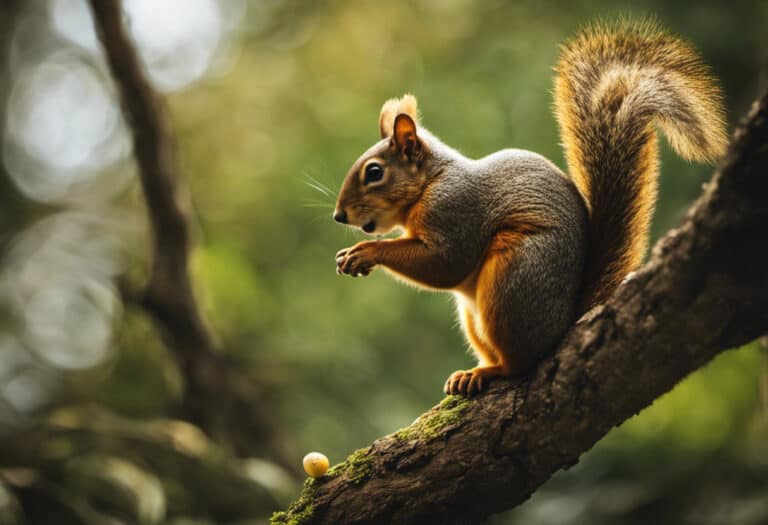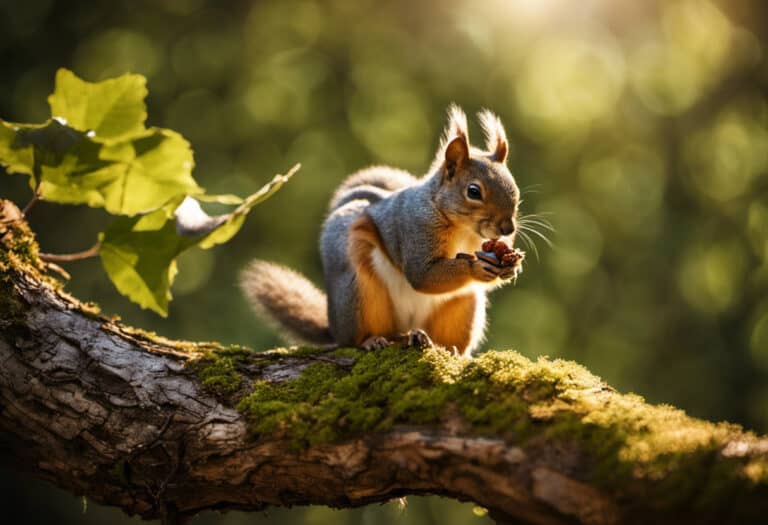How to Tell if a Squirrel Has Rabies
Do you ever wonder how to tell if a squirrel has rabies? Well, you’re in luck! In this informative article, we will delve into the physical symptoms, behavioral changes, and identifying aggression in squirrels that may indicate the presence of rabies.
We will also explore unusual vocalizations, abnormal movements, and signs of paralysis or weakness. By distinguishing rabies from other diseases, you will be equipped with the knowledge to take appropriate action if you suspect a squirrel has rabies.
So, let’s get started!
Key Takeaways
- Physical symptoms of rabies in squirrels include aggressive behavior, disorientation and lack of coordination, excessive salivation, drooping eyelids, and paralysis or weakness in hind legs.
- Behavioral changes to look out for include unusual aggression towards humans or animals, abnormal vocalizations (loud, high-pitched noises), abnormal movements (repetitive, jerky motions), signs of distress or agitation, and a change in territorial behavior.
- Triggers for unusual aggression in squirrels can include the presence of predators, protecting their territory, lack of food availability, and maternal protection instinct.
- Abnormal vocalizations or movements such as growling, screaming, high-pitched squeals, stumbling, falling, biting, attacking, disorientation, drooling, and paralysis can be signs of rabies, and it is important to avoid direct contact and seek professional help.
Physical Symptoms of Rabies in Squirrels
The physical symptoms of rabies in squirrels can include aggressive behavior and disorientation. If you suspect a squirrel may have rabies, it is important to be able to identify the signs. Rabies affects the central nervous system, leading to behavioral changes in squirrels.
One of the most noticeable symptoms is aggression. Rabid squirrels may become unusually aggressive and attack without provocation. They may also exhibit disorientation, appearing confused and uncoordinated in their movements.
Other physical signs of rabies in squirrels include excessive salivation, drooping eyelids, and difficulty swallowing. Additionally, infected squirrels may experience paralysis or weakness in their hind legs.
If you observe these symptoms in a squirrel, it is best to avoid contact and report it to local animal control or wildlife authorities for further investigation.
Behavioral Changes to Look Out for
If you observe unusual aggression in squirrels, abnormal vocalizations, or movements, it is important to take note of these behavioral changes.
Unusual aggression can manifest as squirrels displaying aggression towards humans or other animals without any apparent provocation.
Abnormal vocalizations or movements may include squirrels making loud, high-pitched noises or engaging in repetitive, jerky motions.
These behaviors could be indicative of underlying health issues or possible infections, and it is advised to seek professional help if you witness such changes in squirrel behavior.
Unusual Aggression in Squirrels
You’ll want to be cautious if you notice squirrels displaying unusual aggression. Aggression in squirrels is not a common behavior, and it may be a sign of underlying issues or triggers. Understanding these triggers can help you handle aggressive squirrels safely and effectively.
Here is a table that outlines some common triggers and appropriate handling techniques for aggressive squirrels:
| Unusual Aggression Triggers | Handling Aggressive Squirrels |
|---|---|
| – Presence of predators | – Keep your distance and avoid direct contact |
| – Protecting their territory | – Give them space and avoid provoking them |
| – Lack of food availability | – Provide food sources to alleviate aggression |
| – Maternal protection instinct | – Keep away from nesting areas and be cautious around baby squirrels |
Abnormal Vocalizations or Movements
Abnormal vocalizations or movements in squirrels can indicate potential health issues or distress. When it comes to identifying rabid animals, it is important to know the symptoms of rabies in wildlife.
Squirrels infected with rabies may exhibit unusual behaviors such as growling, screaming, or making high-pitched squeals. These abnormal vocalizations are often accompanied by erratic movements, such as stumbling or falling. Rabid squirrels may also display aggressive behavior, biting or attacking without provocation.
Other symptoms to look out for include disorientation, drooling, and paralysis. If you come across a squirrel displaying these signs, it is crucial to exercise caution and avoid any direct contact. Remember, squirrels with rabies pose a risk to human health, so it is best to contact your local animal control or wildlife rehabilitation center for assistance.
Identifying Aggression in Squirrels
When a squirrel exhibits aggressive behavior, it may be a sign of rabies. It is crucial to be able to identify aggression in squirrels in order to prevent squirrel bites and handle aggressive squirrels safely.
Aggressive squirrels often display behaviors such as lunging, hissing, biting, or chasing. These actions are a clear indication that the squirrel is feeling threatened or territorial.
If you encounter an aggressive squirrel, it is important to avoid making sudden movements or loud noises as these can further provoke the squirrel. Instead, slowly back away while keeping an eye on the squirrel’s movements.
If you are bitten by an aggressive squirrel, seek medical attention immediately to assess the risk of rabies transmission and receive appropriate treatment.
Unusual Vocalizations and Sounds
When it comes to squirrels, their vocalizations can sometimes be abnormal and strange. These unusual sounds can range from high-pitched screeches to low growls, and it’s important to understand what they mean.
In the case of a rabid squirrel, their noises can be particularly unusual, indicating a state of distress or aggression.
Squirrel’s Abnormal Vocalizations
If a squirrel starts making strange noises, it could be a sign of rabies. Squirrels have various communication methods to convey their intentions and emotions. They use vocalizations, body language, and scent marking to interact with other squirrels and the environment.
Understanding squirrel behavior is essential in identifying abnormal vocalizations that may indicate the presence of rabies. Normally, squirrels produce chattering and barking sounds to communicate with each other. However, if you hear high-pitched screams, growls, or continuous screeching, it is crucial to exercise caution. These abnormal vocalizations could be a result of the virus affecting the squirrel’s central nervous system.
If you encounter a squirrel displaying such unusual noises, it is recommended to avoid any contact and report the incident to local animal control authorities immediately for further assistance.
Strange Sounds From Squirrels
Strange vocalizations in squirrels can be intriguing and sometimes even alarming. These unusual sounds are an important aspect of their communication methods. Here are some strange sounds that squirrels may make:
-
Chattering: Squirrels often emit a rapid series of high-pitched chattering sounds. This can be a sign of excitement or agitation.
-
Barking: Squirrels may produce a barking noise when they feel threatened or sense danger nearby.
-
Whistling: Some squirrels emit a high-pitched whistle as a warning signal to other squirrels in the area.
-
Moaning: Occasionally, squirrels may make a moaning sound, which could indicate distress or pain.
-
Clicking: Squirrels may produce a clicking noise by rapidly grinding their teeth together. This behavior is often observed when they are irritated or annoyed.
Rabid Squirrel’s Unusual Noises
Listen closely for any abnormal sounds coming from the squirrel, as this could indicate that it’s infected with rabies. Rabid squirrel’s vocalizations can be quite distinct and different from those of a healthy squirrel. Pay attention to any high-pitched screeching, growling, or unusual squealing noises. These sounds can be a sign of distress and aggression, which are common symptoms of rabies.
Additionally, observe the squirrel’s abnormal movements. Rabid squirrels may exhibit uncoordinated and jerky movements, such as stumbling or falling over. They may also display aggressive behavior, such as lunging or biting.
It’s crucial to stay away from any squirrel displaying these signs, as rabies is a serious viral infection that can be transmitted through bites or scratches. If you suspect a squirrel to be rabid, contact your local animal control for assistance.
Abnormal Movements and Coordination
You might notice that a squirrel with rabies has difficulty moving and coordinating its actions. This is because rabies affects the nervous system, causing abnormal postures, tremors, and seizures.
Here are some signs to look out for:
-
Abnormal postures: Rabid squirrels may have a hunched or twisted appearance, as their muscles are affected by the virus.
-
Tremors: You may observe the squirrel shaking or trembling uncontrollably, especially in its limbs.
-
Seizures: Squirrels with rabies can experience seizures, which are characterized by sudden, violent movements and convulsions.
-
Lack of coordination: Rabid squirrels may stumble or have trouble walking in a straight line, due to the virus affecting their motor skills.
-
Inability to climb: Normally agile climbers, rabid squirrels may struggle to climb trees or structures.
If you witness any of these symptoms in a squirrel, it is important to keep your distance and contact animal control or a wildlife professional for assistance.
Signs of Paralysis or Weakness
If you suspect a squirrel may have rabies, it’s important to look out for signs of paralysis or weakness. Rabies can affect the nervous system, leading to muscle atrophy and difficulties with movement. Keep an eye out for any squirrels that seem to have trouble climbing, walking, or balancing. They may appear unsteady or have a limp. Additionally, observe any changes in their eating habits. Squirrels with rabies may have difficulty chewing or swallowing, leading to a decrease in their food intake. To help you identify these signs more easily, here is a table showcasing the various signs of paralysis or weakness and changes in eating habits that you should be on the lookout for:
| Signs of Paralysis or Weakness | Changes in Eating Habits |
|---|---|
| Difficulty climbing or walking | Decreased food intake |
| Unsteady or limping | Trouble chewing or swallowing |
Distinguishing Rabies From Other Diseases
To better distinguish rabies from other diseases, it’s important to consider additional symptoms and behaviors exhibited by squirrels. While the presence of paralysis or weakness can indicate various illnesses, there are specific signs that can help in diagnosing rabies in squirrels. Here are some key indicators to look for:
- Aggressive behavior: Rabid squirrels may exhibit uncharacteristic aggression, biting or attacking without provocation.
- Excessive salivation: Squirrels infected with rabies often drool excessively due to difficulty swallowing.
- Disorientation and confusion: Rabies can cause neurological symptoms, leading to disorientation and confusion in squirrels.
- Unsteady movements: Infected squirrels may display uncoordinated and unsteady movements, stumbling or falling.
- Vocalizations: Rabid squirrels may emit unusual vocalizations such as high-pitched screeching or growling.
What to Do if You Suspect a Squirrel Has Rabies
When suspecting a squirrel has rabies, it’s crucial to contact local animal control or a wildlife rehabilitator for assistance. Rabies is a serious viral disease that affects the nervous system of mammals, including squirrels. The virus is transmitted through the saliva of infected animals, often through bites.
If you encounter a squirrel that displays unusual behavior such as aggression, disorientation, or difficulty walking, it’s important to stay safe and avoid any direct contact with the animal. Keep a safe distance and do not attempt to handle or capture the squirrel yourself.
Contacting animal control or a wildlife rehabilitator ensures that trained professionals can assess the situation, safely capture the squirrel if necessary, and provide the appropriate care or euthanization if it is confirmed to have rabies.
Frequently Asked Questions
Can Squirrels Transmit Rabies to Humans?
Squirrels can transmit rabies to humans. To determine if a squirrel has rabies, observe its behavior for signs such as aggression, disorientation, and foaming at the mouth. Seek immediate medical attention if bitten.
How Common Is Rabies in Squirrels?
Rabies transmission in squirrels is rare, but it’s important to take precautions. Preventing contact with potentially infected animals and vaccinating pets can reduce the risk. If you suspect a squirrel has rabies, contact animal control for assistance.
What Is the Incubation Period for Rabies in Squirrels?
The incubation period for rabies in squirrels can vary, but it typically ranges from 20 to 60 days. During this time, the virus multiplies in the body, leading to the onset of symptoms.
Can Squirrels Recover From Rabies on Their Own?
Squirrels cannot self-heal from rabies. Once infected, the squirrel’s immune response to rabies is not sufficient to eliminate the virus. Rabies is a fatal disease for squirrels, and they require medical intervention.
Is There a Vaccine Available to Prevent Rabies in Squirrels?
There is currently no vaccine available to prevent rabies in squirrels. However, there are prevention methods that can be taken to minimize the risk of squirrels contracting rabies.
Conclusion
In conclusion, if you suspect a squirrel has rabies, it’s important to look out for physical symptoms such as abnormal movements, paralysis, and weakness. Behavioral changes, aggression, and unusual vocalizations can also indicate rabies.
Remember to distinguish rabies from other diseases as the symptoms may overlap. If you encounter a potentially rabid squirrel, contact your local animal control or wildlife agency for assistance.
Stay safe and informed when dealing with wildlife. After all, knowledge is the key to prevention and protection.






